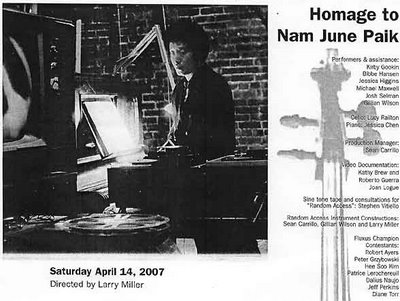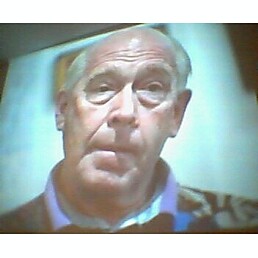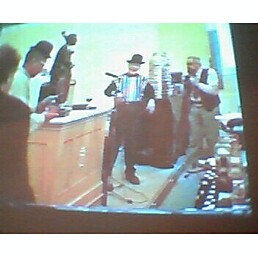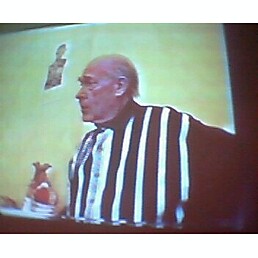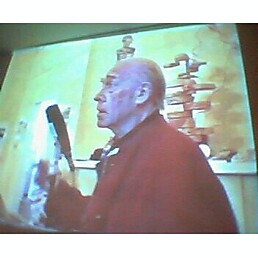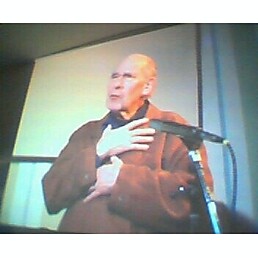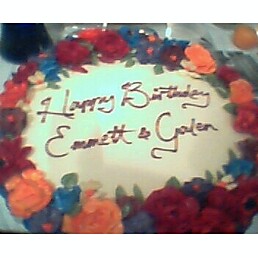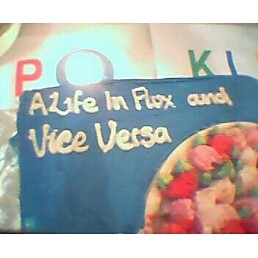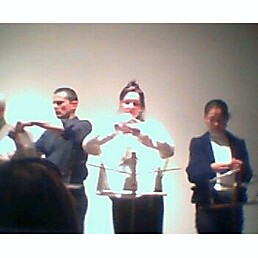ONLY ONE LARRY MILLER
Only one Miller-Paik. Saturday April 14, 2007. Renowned Fluxus artist Larry Miller pays homage to Nam June Paik with his “variations, adaptations, improvisations, bastardizations” (Miller) of Paik’s performance pieces at the James Cohan Gallery, Chelsea. Paik inspired, the series of performances were indeed one of a kind Miller pieces. And it is through this sort of reliving, reviving, revisiting, resetting Paik that keeps him alive and the only way to truly pay homage to a man who we know as Paik, as Miller would say, with integrity.
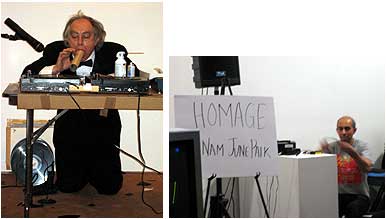
Some people still talk about Paik as the good businessman. One only cares if he is or not, if he is a great artist first. From salesman to artist, Paik’s identity was most confused as he became more of a star commodity. I remember how I would hear that he was aggravated not to yet be collected or showing at MOMA and that somehow that had to do with him being Korean, or at least not white. It must have been interesting to be able to have toggled back and forth between the unfortunate to the very fortunate Asian figure, and what an advantage being able to play such ambiguous roles as, in every sense, from Asian, and not quite so, to artist, con-artist, businessman, performer etc…
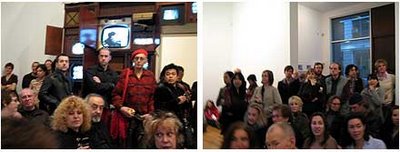
So Paik very frequently introduced Asian or Korean somethingness, Buddha, shaman, traditional percussion, folk etc. Each cultural tandem varies depending on situation and event; what nationality was the TV-Buddha anyway? Then again, what nationality was Paik? But no one can really question his motives since his was marked privilege and this allowed him to create tantalizing and teasing moments of art. And his performances were somehow most effective since the most ambiguous of Paik’s identity was in the performative element of his work. Miller then, realizes that this was somewhat an opportunity. Not just to re-perform Paik’s scores but to play and perform his spirit. Would that not be truly Paik-esque? But also Miller.
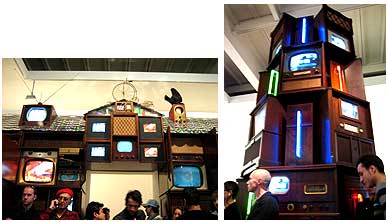
The setting for the evening of performance was perfect. The performance stage was the gallery space between two of Paik’s overarching pieces. As you entered the room, to the left was the In-Flux House (1993) that is like a gatehouse to the other room with Paik’s robot pieces and to the right was the Tower (2001) which was tower made of monitors that had direct live feed of the performance that evening.
Appropriately enough, the first piece of the evening was all media. Five televisions and one radio all turned on for media as music, Flux Radio & TV (Realization from “FluxFest Kit 2” published by George Maciunas 1969).*
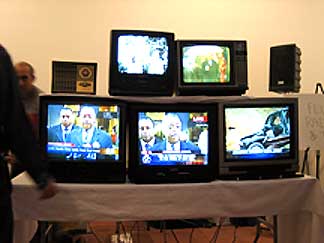
Then Miller starts talking about Paik and Charlotte Moorman, that you cannot have him without her. Miller points out Moorman’s ability to organize large Avant-garde festivals, which she did since 1963, and sometimes working with over 400 artists on them. Miller’s first encounter to the Avant-garde diva Moorman was when she flew by on a helium balloon over Central Park West, followed by many other artists behind her. The Variations on a Theme by Saint-Saens 1964 (Le Cygne, The Swan, excerpt from “Le Carnaval des Animeaux,” based upon performances by Charlotte Moorman, 1933-1991) was performed by pianist Jessica Chen and cellist Lucy Railton. They played classical music until it was time for Railton to get escorted by Miller inside a man-size oil drum full of water. She comes out drenched and still continues to play her cello.
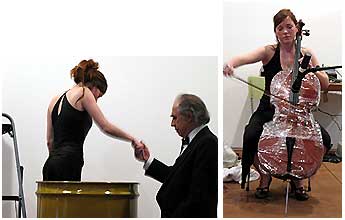
The next piece Zen for Head 1962 (Paik’s interpretation of LaMonte Young’s “Composition 1960 #10, to Bob Morris, Yin Yang Version by Larry Miller 1992) was a beautiful hybrid. From Young’s score of “draw a straight line and follow it” (Miller tells us that evening) to Paik’s variation of just dumping his head in a bucket of ink to draw a Zen line with it (defeating Zen-ness), we see Miller’s two person composition Yin Yang version of Zen for Head. Jessica Higgins and Michael Maxwell simultaneously draws lines with their heads, Higgins in black ink and Maxwell in white, both on canvas, back to back, never before were Zen lines criss-crossed like this.
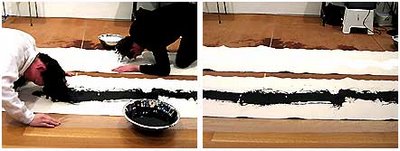
Miller comes out solo with a toy piano. He takes his beret and covers his face, a Miller classic, then starts banging the piano on his head. What was the fixation over head for Paik? Paik must have been laughing as Miller pounds his head with the toy piano over and over again. The audience laughed too at the rather humorous yet disturbing moment. This was a very nice contribution, the 13th Piano Composition for Nam June Paik, this time by Miller.
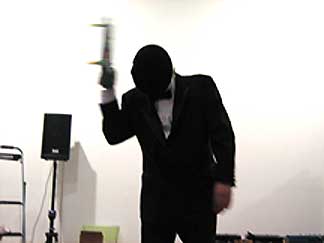
Adaptations from Random Access 1963 was the highlight of the evening. The sine tone tape and consultation was acknowledged to Stephen Vitiello and the instrument construction was done by Miller’s production manager Sean Carrilo, Gillian Wilson, and Miller and performed by Bibbe Hansen, Miller, Maxwell, and Wilson. Hansen DJed a custom designed multi-stack LP player while flaring the needle part like a magic wand creating interruptive sound. Maxwell and Wilson played the strips of audiotapes with the movable sound pick up and Miller destroyed his record player and albums with various things including chewing gum and electric drill. This performance was a mutated, mutilated Random Access which was quite powerful to listen to.
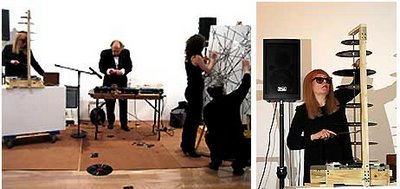
The next piece was Fluxus Champion Contest 1962, an international pissing contest with contestants from England, Scotland, France, US, Poland, Lithuania, France, and Korea. The Scottish winner who pissed the longest (and omni-directionally) won the decorated and signed toilet seat by Miller. At this point, the whole evening was turned up side down. Later, only a couple of us knew that the winner was a (s)he not a ()he, Diane Torr, who had her breasts taped, mustache drawn, and wearing some form of device, who knows what really happened.
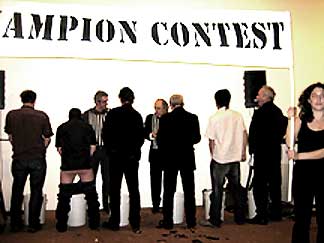
Lastly, on a contemplative note, not one but two Candle TV 1975 were performed. Side by side the two monitors had candlelight burning, softly, in memory of Paik. It was a kind of new stereo-vision of Paik.
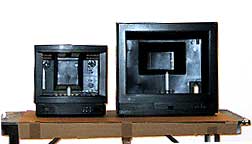
This writing covers the second of two of Larry Miller’s Homage to Nam June Paik events at the James Cohan Gallery. The first evening of performance was on Saturday March 24th which had the classic instrument performances such as 12 Piano Compositions for Nam June Paik by George Maciunas 1962, where rumor has it that Miller did all twelve compositions, which was never done before, as well as performing the famous Paik’s One for Violin Solo 1962. Unfortunately, I was only able to make it to the second evening of which I have the honor to write about. Two Candle TV, two Zen for Head, two nights of evening performance. Two seems like an interesting theme for Only One Larry Miller. It certainly sets a great opposition between the reproduction/binary and original/singularity. On this Miller-Paik occasion, a tie for a tie.
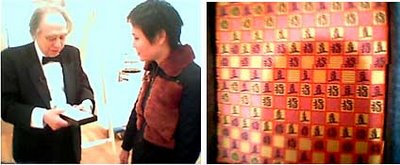
~Mina Cheon
After the evening an artist organized Candle TV event, Italian restaurant “Pepe Giallo,” Gabriel Kroiz, Mina Cheon and Miller-Paik Candle TV by and with Joshua Selman for Nam June Paik and Larry Miller.
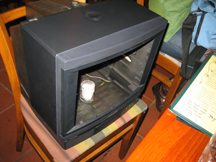

Some people still talk about Paik as the good businessman. One only cares if he is or not, if he is a great artist first. From salesman to artist, Paik’s identity was most confused as he became more of a star commodity. I remember how I would hear that he was aggravated not to yet be collected or showing at MOMA and that somehow that had to do with him being Korean, or at least not white. It must have been interesting to be able to have toggled back and forth between the unfortunate to the very fortunate Asian figure, and what an advantage being able to play such ambiguous roles as, in every sense, from Asian, and not quite so, to artist, con-artist, businessman, performer etc…

So Paik very frequently introduced Asian or Korean somethingness, Buddha, shaman, traditional percussion, folk etc. Each cultural tandem varies depending on situation and event; what nationality was the TV-Buddha anyway? Then again, what nationality was Paik? But no one can really question his motives since his was marked privilege and this allowed him to create tantalizing and teasing moments of art. And his performances were somehow most effective since the most ambiguous of Paik’s identity was in the performative element of his work. Miller then, realizes that this was somewhat an opportunity. Not just to re-perform Paik’s scores but to play and perform his spirit. Would that not be truly Paik-esque? But also Miller.

The setting for the evening of performance was perfect. The performance stage was the gallery space between two of Paik’s overarching pieces. As you entered the room, to the left was the In-Flux House (1993) that is like a gatehouse to the other room with Paik’s robot pieces and to the right was the Tower (2001) which was tower made of monitors that had direct live feed of the performance that evening.
Appropriately enough, the first piece of the evening was all media. Five televisions and one radio all turned on for media as music, Flux Radio & TV (Realization from “FluxFest Kit 2” published by George Maciunas 1969).*

Then Miller starts talking about Paik and Charlotte Moorman, that you cannot have him without her. Miller points out Moorman’s ability to organize large Avant-garde festivals, which she did since 1963, and sometimes working with over 400 artists on them. Miller’s first encounter to the Avant-garde diva Moorman was when she flew by on a helium balloon over Central Park West, followed by many other artists behind her. The Variations on a Theme by Saint-Saens 1964 (Le Cygne, The Swan, excerpt from “Le Carnaval des Animeaux,” based upon performances by Charlotte Moorman, 1933-1991) was performed by pianist Jessica Chen and cellist Lucy Railton. They played classical music until it was time for Railton to get escorted by Miller inside a man-size oil drum full of water. She comes out drenched and still continues to play her cello.

The next piece Zen for Head 1962 (Paik’s interpretation of LaMonte Young’s “Composition 1960 #10, to Bob Morris, Yin Yang Version by Larry Miller 1992) was a beautiful hybrid. From Young’s score of “draw a straight line and follow it” (Miller tells us that evening) to Paik’s variation of just dumping his head in a bucket of ink to draw a Zen line with it (defeating Zen-ness), we see Miller’s two person composition Yin Yang version of Zen for Head. Jessica Higgins and Michael Maxwell simultaneously draws lines with their heads, Higgins in black ink and Maxwell in white, both on canvas, back to back, never before were Zen lines criss-crossed like this.

Miller comes out solo with a toy piano. He takes his beret and covers his face, a Miller classic, then starts banging the piano on his head. What was the fixation over head for Paik? Paik must have been laughing as Miller pounds his head with the toy piano over and over again. The audience laughed too at the rather humorous yet disturbing moment. This was a very nice contribution, the 13th Piano Composition for Nam June Paik, this time by Miller.

Adaptations from Random Access 1963 was the highlight of the evening. The sine tone tape and consultation was acknowledged to Stephen Vitiello and the instrument construction was done by Miller’s production manager Sean Carrilo, Gillian Wilson, and Miller and performed by Bibbe Hansen, Miller, Maxwell, and Wilson. Hansen DJed a custom designed multi-stack LP player while flaring the needle part like a magic wand creating interruptive sound. Maxwell and Wilson played the strips of audiotapes with the movable sound pick up and Miller destroyed his record player and albums with various things including chewing gum and electric drill. This performance was a mutated, mutilated Random Access which was quite powerful to listen to.

The next piece was Fluxus Champion Contest 1962, an international pissing contest with contestants from England, Scotland, France, US, Poland, Lithuania, France, and Korea. The Scottish winner who pissed the longest (and omni-directionally) won the decorated and signed toilet seat by Miller. At this point, the whole evening was turned up side down. Later, only a couple of us knew that the winner was a (s)he not a ()he, Diane Torr, who had her breasts taped, mustache drawn, and wearing some form of device, who knows what really happened.

Lastly, on a contemplative note, not one but two Candle TV 1975 were performed. Side by side the two monitors had candlelight burning, softly, in memory of Paik. It was a kind of new stereo-vision of Paik.

This writing covers the second of two of Larry Miller’s Homage to Nam June Paik events at the James Cohan Gallery. The first evening of performance was on Saturday March 24th which had the classic instrument performances such as 12 Piano Compositions for Nam June Paik by George Maciunas 1962, where rumor has it that Miller did all twelve compositions, which was never done before, as well as performing the famous Paik’s One for Violin Solo 1962. Unfortunately, I was only able to make it to the second evening of which I have the honor to write about. Two Candle TV, two Zen for Head, two nights of evening performance. Two seems like an interesting theme for Only One Larry Miller. It certainly sets a great opposition between the reproduction/binary and original/singularity. On this Miller-Paik occasion, a tie for a tie.

~Mina Cheon
After the evening an artist organized Candle TV event, Italian restaurant “Pepe Giallo,” Gabriel Kroiz, Mina Cheon and Miller-Paik Candle TV by and with Joshua Selman for Nam June Paik and Larry Miller.

Candle TV Dinner
meal, table, candle light and chairs provided by restaurant
bring Candle TV
place candle inside
share thoughts on Paik during meal
* Titles and descriptions of Nam June Paik performance pieces were originally written in the evening program directed by Larry Miller.
Appropriating from the site: http://www.artnotart.com/fluxus/gmaciunas-12pianocompositi.html
12 PIANO COMPOSITIONS FOR NAM JUNE PAIK, by George Maciunas, Jan. 2, 1962.
Composition no.1 — no.12 & no. 13 by Larry Miller April 14, 2007
1. let piano movers carry piano into the stage
2. tune the piano
3. paint with orange paint patterns over piano
4. with a straight stick the length of a keyboard sound all keys together
5. place a dog or cat (or both) inside the piano and play Chopin
6. stretch 3 higest strings with tuning key until they burst
7. place one piano on top of one another (one can be smaller)
8. place piano upside down and put a vase with flowers over the sound box
9. draw a picture of the piano so that the audience can see the picture
10. write ‘piano composition no.10′ and show to the audience the sign
11. was the piano, wax and polish it well
12. let piano movers carry piano out of the stage
13. Piano for Head (for Nam June Paik) by Larry Miller 2007
